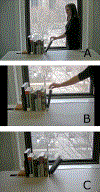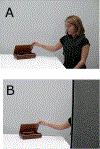Occluding the face diminishes the conceptual accessibility of an animate agent
- PMID: 33015215
- PMCID: PMC7531273
- DOI: 10.1080/23273798.2018.1525495
Occluding the face diminishes the conceptual accessibility of an animate agent
Abstract
The language that people use to describe events reflects their perspective on the event. This linguistic encoding is influenced by conceptual accessibility, particularly whether individuals in the event are animate or agentive--animates are more likely than inanimates to appear as Subject of a sentence, and agents are more likely than patients to appear as Subject. We tested whether perceptual aspects of a scene can override these two conceptual biases when they are aligned: whether a visually prominent inanimate patient will be selected as Subject when pitted against a visually backgrounded animate agent. We manipulated visual prominence by contrasting scenes in which the face/torso/hand of the agent were visible vs. scenes in which only the hand was visible. Events with only a hand were more often associated with passive descriptions, in both production and comprehension tasks. These results highlight the power of visual prominence to guide how people conceptualize events.
Keywords: animacy; event representation; passive voice; sentence production.
Figures






Similar articles
-
Describing Events: Changes in Eye Movements and Language Production Due to Visual and Conceptual Properties of Scenes.Front Psychol. 2019 Apr 17;10:835. doi: 10.3389/fpsyg.2019.00835. eCollection 2019. Front Psychol. 2019. PMID: 31057462 Free PMC article.
-
Differential effects of agency, animacy, and syntactic prominence on production and comprehension: Evidence from a verb-initial language.Can J Exp Psychol. 2022 Dec;76(4):302-326. doi: 10.1037/cep0000280. Epub 2022 Apr 28. Can J Exp Psychol. 2022. PMID: 35482621
-
When a Stone Tries to Climb up a Slope: The Interplay between Lexical and Perceptual Animacy in Referential Choices.Front Psychol. 2013 Apr 1;4:154. doi: 10.3389/fpsyg.2013.00154. eCollection 2013. Front Psychol. 2013. PMID: 23554600 Free PMC article.
-
I like the way you move: how animate motion affects visual attention in early human infancy.Front Neurosci. 2024 Aug 13;18:1459550. doi: 10.3389/fnins.2024.1459550. eCollection 2024. Front Neurosci. 2024. PMID: 39193524 Free PMC article. Review.
-
Developmental origin of the animate-inanimate distinction.Psychol Bull. 2001 Mar;127(2):209-28. doi: 10.1037/0033-2909.127.2.209. Psychol Bull. 2001. PMID: 11316011 Review.
Cited by
-
Speakers prioritise affordance-based object semantics in scene descriptions.Lang Cogn Neurosci. 2023;38(8):1045-1067. doi: 10.1080/23273798.2023.2190136. Epub 2023 Mar 30. Lang Cogn Neurosci. 2023. PMID: 37841974 Free PMC article.
-
Agency effects on the binding of event elements in episodic memory.Q J Exp Psychol (Hove). 2024 Jun;77(6):1201-1220. doi: 10.1177/17470218231203951. Epub 2023 Oct 31. Q J Exp Psychol (Hove). 2024. PMID: 37742043 Free PMC article.
-
The communicative importance of agent-backgrounding: Evidence from homesign and Nicaraguan Sign Language.Cognition. 2020 Oct;203:104332. doi: 10.1016/j.cognition.2020.104332. Epub 2020 Jun 16. Cognition. 2020. PMID: 32559513 Free PMC article.
-
Describing Events: Changes in Eye Movements and Language Production Due to Visual and Conceptual Properties of Scenes.Front Psychol. 2019 Apr 17;10:835. doi: 10.3389/fpsyg.2019.00835. eCollection 2019. Front Psychol. 2019. PMID: 31057462 Free PMC article.
References
-
- Aissen J (2003). Differential Object Marking: Iconicity vs. Economy. Natural Language & Linguistic Theory, 21(3), 435–483. doi:10.1023/a:1024109008573
-
- Altmann LJP, & Kemper S (2006). Effects of age, animacy and activation order on sentence production. Language and Cognitive Processes, 21(1–3), 322–354. doi:10.1080/0169096054400006 - DOI
-
- Antón-Méndez I (2017). Visual salience effects on speaker choices: Direct or indirect influences on linguistic processing? Applied Psycholinguistics, 38(3), 601–631. doi:10.1017/S0142716416000345 - DOI
-
- Bates D, & Maechler M (2009). lme4: linear mixed effects models using S4 classes (Vol. R package version 0.999375–31)
Grants and funding
LinkOut - more resources
Full Text Sources
Other Literature Sources
